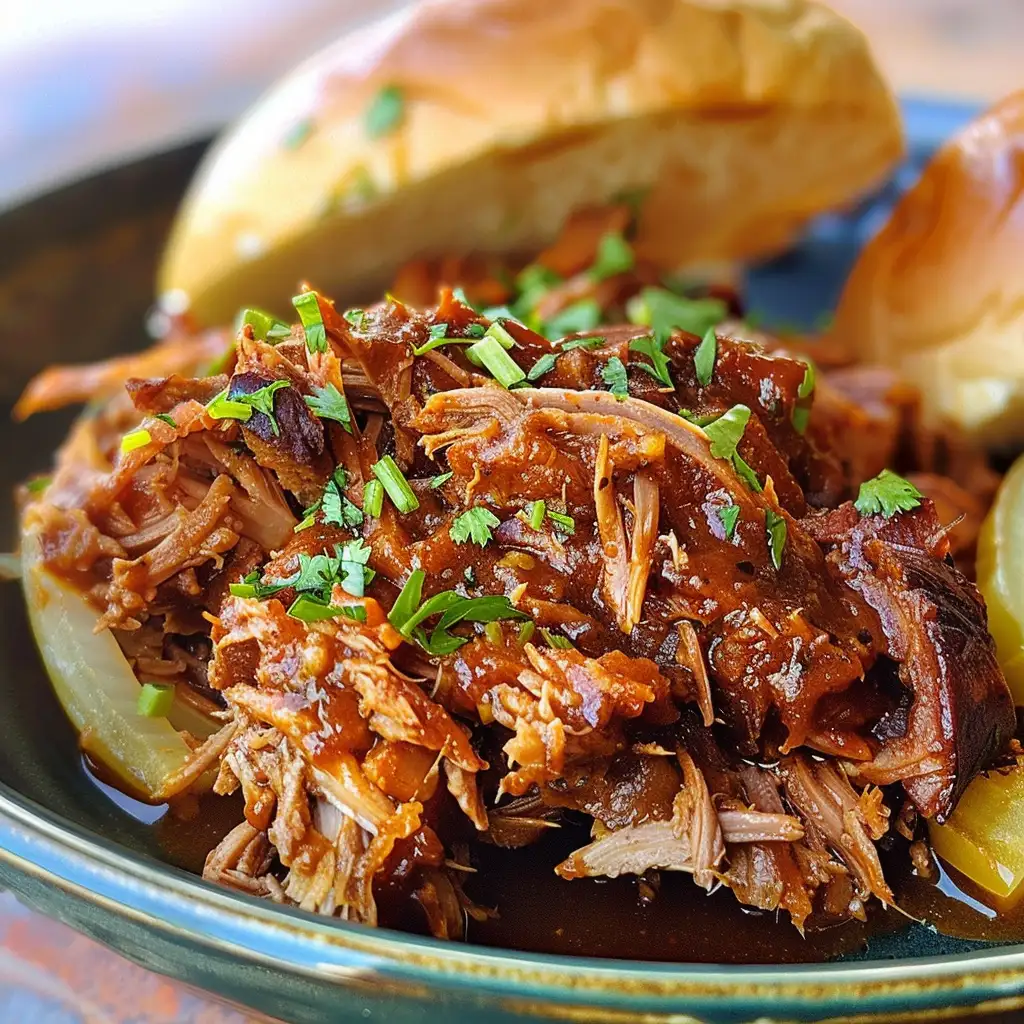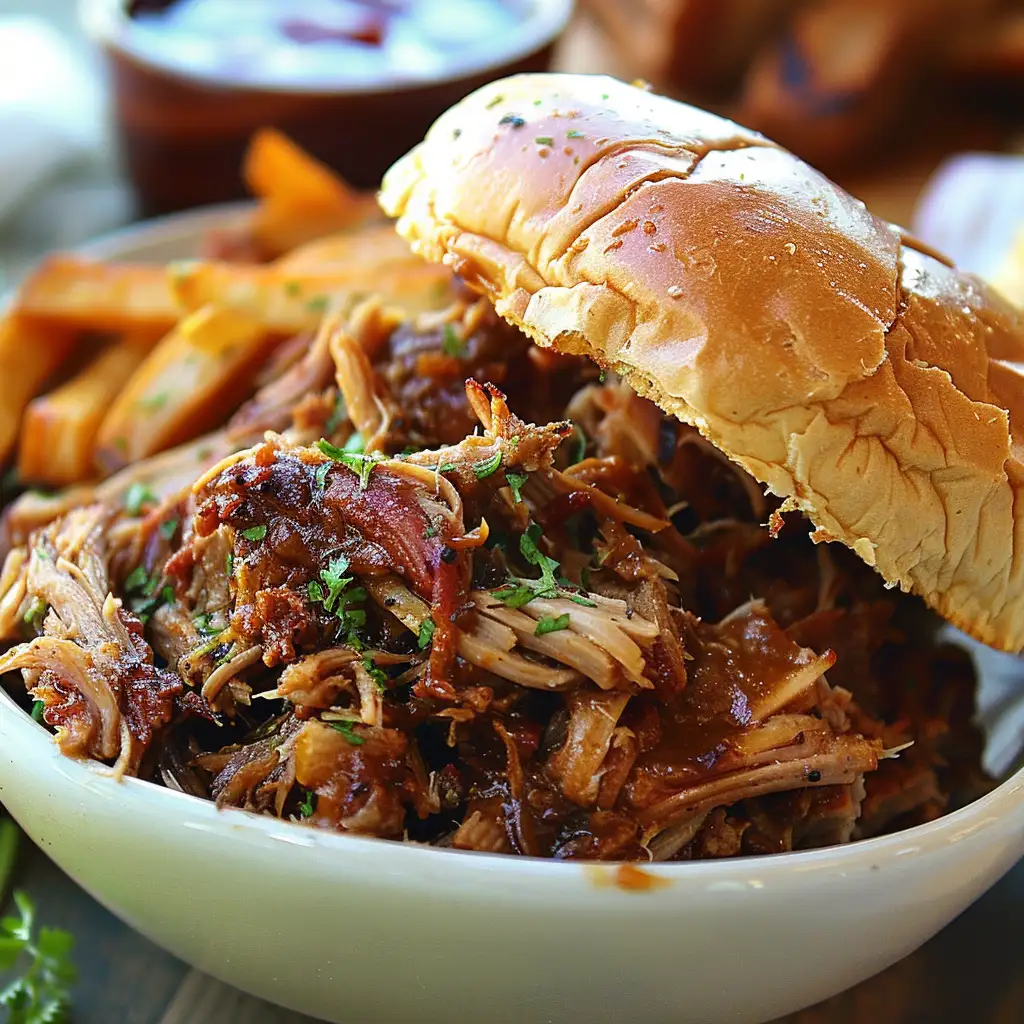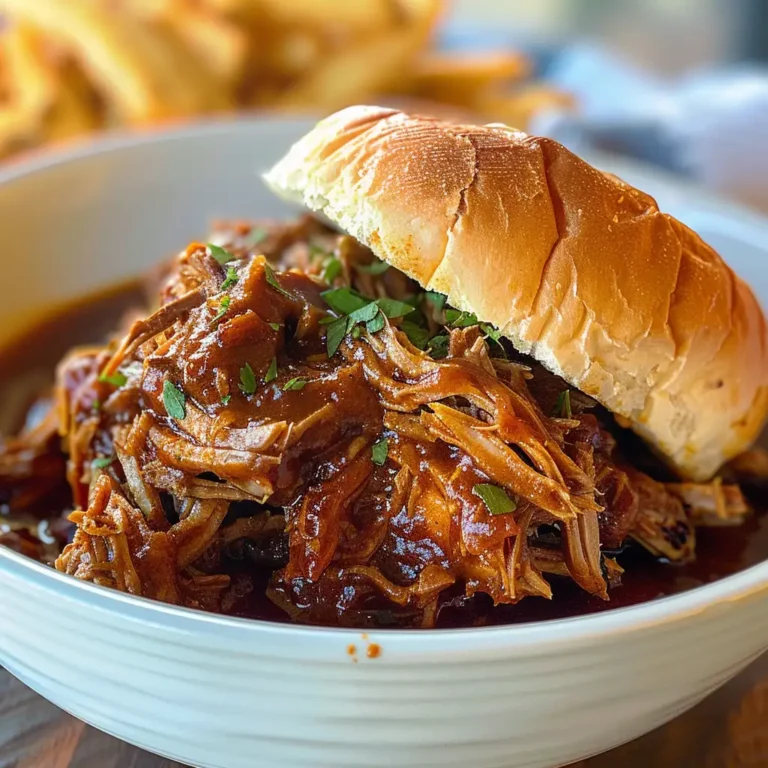Introduction to Texas Pulled Pork
Texas-style pulled pork captures the essence of traditional American barbecue with its rich flavors, tender texture, and deep-rooted history in the culinary landscape. This dish is more than just food; it’s a celebration of culture, bringing together friends and family over a meal that’s both hearty and deeply satisfying.
- Texas-style pulled pork is renowned for its slow-cooked tenderness and smoky, tangy barbecue sauce that envelopes every shred of meat.
- The method of cooking pork over low heat for several hours allows the flavors to meld together beautifully, creating a dish that is both flavorful and incredibly tender.
Cooking with a slow cooker offers a modern twist on this traditional recipe, making it accessible to home cooks everywhere. This method not only simplifies the cooking process but also ensures that the pork is cooked to perfection, retaining its moisture and flavor.
By leveraging the slow cooker, enthusiasts can recreate the authentic taste of Texas barbecue in their own kitchens. For those looking to dive deeper into the world of barbecue and slow cooking, resources like Southern Living provide a wealth of information on complementary dishes and tips to enhance your barbecue experience.
Whether you’re a seasoned pitmaster or a home cook, the allure of Texas pulled pork lies in its simplicity and the depth of flavor achieved through slow cooking. It’s a testament to the power of patience and the magic of melding simple ingredients into a dish that’s truly to die for.
The Ultimate Slow Cooker Texas Pulled Pork Recipe
Embarking on the journey to create the ultimate Slow Cooker Texas Pulled Pork involves a blend of traditional cooking techniques with the convenience of modern appliances. This recipe is a testament to the timeless appeal of slow-cooked meats, imbued with the rich, smoky flavors that are the hallmark of Texas barbecue.

Introduction to the Classic Recipe
- Texas Pulled Pork is not just a dish; it’s an experience. The slow cooker method transforms a simple pork shoulder into a succulent feast, enveloped in a tangy, sweet, and smoky sauce.
Ingredients Needed
- Pork shoulder: The star of the show, known for its fat marbling, which renders into tender meat.
- Vegetable oil: Aids in the initial searing of the pork.
- Barbecue sauce: Provides the base of the dish’s moisture and flavor.
- Yellow mustard and Worcestershire sauce: Add depth and a tangy kick.
- Apple cider vinegar: Introduces acidity, balancing the sweetness.
- Chicken broth: Enhances the meat’s flavor while keeping it moist during cooking.
- Brown sugar: Adds sweetness and caramelization.
- Chili powder, garlic, and dried thyme: Contribute to the rub’s complex flavor profile.
- Onion: Adds sweetness and flavor depth to the sauce.
- Buns and butter: For serving the pulled pork as sandwiches.
Step-by-Step Cooking Instructions
- Begin by lightly coating the bottom of the slow cooker with vegetable oil.
- Place the pork shoulder in the slow cooker, and generously apply a mixture of chili powder, garlic, and dried thyme as a dry rub.
- In a separate bowl, mix barbecue sauce, yellow mustard, Worcestershire sauce, apple cider vinegar, chicken broth, brown sugar, and chopped onion. Pour this mixture over the pork.
- Cook on low for 8-10 hours or on high for 5-6 hours, until the pork is tender enough to shred easily with a fork.
- Remove the pork from the slow cooker, shred it, and then return it to the pot to soak up the sauce for an additional 30 minutes.
Variations and Personalization of the Recipe
Incorporating Different Rubs and Sauces for a Unique Twist
- Experiment with various barbecue sauces, from sweet to spicy, to find your preferred profile.
- Create your own rub using different spices like smoked paprika or cumin for an added layer of flavor.
Options for Making the Recipe Adaptable to Various Dietary Preferences
- For a lower-sodium version, use low-sodium chicken broth and a homemade barbecue sauce to control the salt content.
- Those looking for a gluten-free option can ensure that all used sauces and broth are certified gluten-free.
By following these detailed instructions and considering the variations, anyone can master the art of making Slow Cooker Texas Pulled Pork. For more insights into slow cooking and tips for achieving the perfect barbecue, exploring resources like Food Network’s Slow Cooker Tips can elevate your cooking game, ensuring your pulled pork is not just good, but legendary.
This recipe showcases the simplicity and beauty of slow-cooked meals, proving that with the right ingredients and a bit of patience, creating mouthwatering dishes is possible for cooks of all skill levels.
Serving Texas Pulled Pork
Savoring Texas Pulled Pork is an experience that extends beyond the main dish. The sides and how you serve the pulled pork play pivotal roles in crafting a memorable meal. Here’s how to complement your pulled pork and construct the ultimate sandwich.

What to Serve With Pulled Pork
The rich, smoky flavors of Texas Pulled Pork pair beautifully with a variety of sides. Here are a few classics:
- Baked Beans: Their sweet and savory profile complements the tangy richness of the pulled pork.
- Simple Macaroni and Cheese: Offers a creamy, comforting counterbalance to the meat’s smoky flavor.
- Traditional Creamy Coleslaw: Adds a crunchy, refreshing contrast to the dish.
Each side dish not only adds to the meal’s flavor complexity but also brings its own textures and tastes that enhance the overall dining experience.
Sandwich Building
Creating the perfect pulled pork sandwich involves more than just piling meat on a bun. Here’s how to elevate your sandwich game:
- Start with a soft, yet sturdy bun that can hold up to the juiciness of the pulled pork without falling apart.
- Add a generous serving of pulled pork, making sure it’s well-coated in sauce.
- Top with creamy coleslaw for crunch and a contrasting flavor.
- Consider additional toppings like pickles or jalapeños for an extra kick.
Mastering the Slow Cooker Technique
Achieving tender, flavorful pulled pork in a slow cooker is both an art and a science. Here are tips and pitfalls to avoid.
Tips for Perfectly Tender Pulled Pork
- Low and Slow: Cooking on a low setting for an extended period ensures maximum tenderness.
- Keep it Covered: Resist the urge to remove the lid frequently, as this lets heat escape and can extend cooking time.
- Choosing the Right Cut: Opt for a pork shoulder or Boston butt for best results, as these cuts are fatty and flavorful.
Common Pitfalls to Avoid
- Overfilling the Slow Cooker: Ensure there’s enough room for heat to circulate, typically filling it no more than two-thirds full.
- Underseasoning: Given the long cooking times, don’t be shy with seasonings as flavors mellow over time.
- Neglecting the Liquid: A sufficient amount of liquid is essential for creating a moist environment that prevents the pork from drying out.
For those eager to dive deeper into slow cooking and barbecue, resources like Academy of Nutrition and Dietetics on Food Safety offer invaluable advice on safely handling and storing your pulled pork, ensuring that every bite is not only delicious but also safe to enjoy.

Everything You Need to Know
Creating the perfect Texas Pulled Pork begins with selecting the right ingredients and understanding how to make the most of your leftovers. Here’s a concise guide to ensure your pulled pork is a hit every time.
How to Select the Right Cut of Meat
- The pork shoulder, also known as Boston butt, is the ideal choice for pulled pork due to its fat content and connective tissues, which melt during the slow cooking process, rendering the meat tender and flavorful.
- Look for a cut with a good balance of meat and fat; too lean, and your pulled pork may end up dry.
Adjusting Cooking Times for Different Sizes of Pork Shoulder
- As a general rule, cook your pork shoulder on low for about 1 to 1.5 hours per pound. However, the exact time can vary based on the size of your cut and your slow cooker.
- Larger cuts may require an extended cooking time to reach the desired tenderness, while smaller cuts might be done sooner. Always check for doneness by testing if the meat easily shreds with a fork.
Dealing with Leftovers: Storage, Reheating, and Recipe Ideas
- Storage: Cool the pulled pork quickly and refrigerate within two hours of cooking. Store in airtight containers for up to four days.
- Reheating: Gently reheat leftovers in a saucepan over low heat, adding a splash of chicken broth or water to keep the pork moist.
- Recipe Ideas: Transform your leftovers into new meals like pulled pork tacos, pizza toppings, or enchiladas for a quick and delicious second act.
For additional guidance on handling and storing leftovers to ensure food safety and quality, consider consulting resources such as Eatright.org, which offers expert advice on food preparation and storage.

